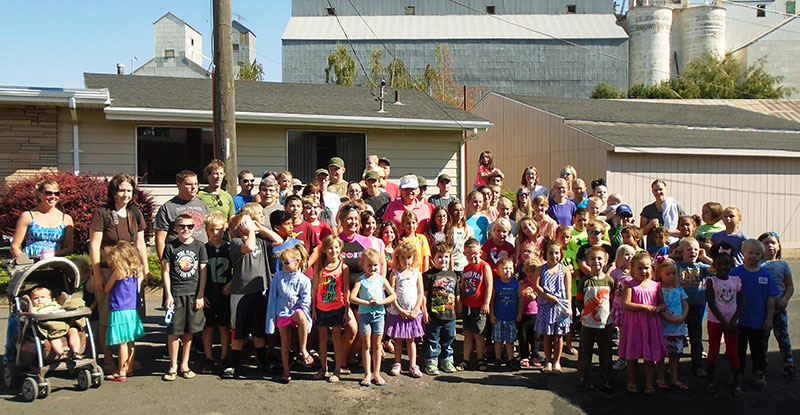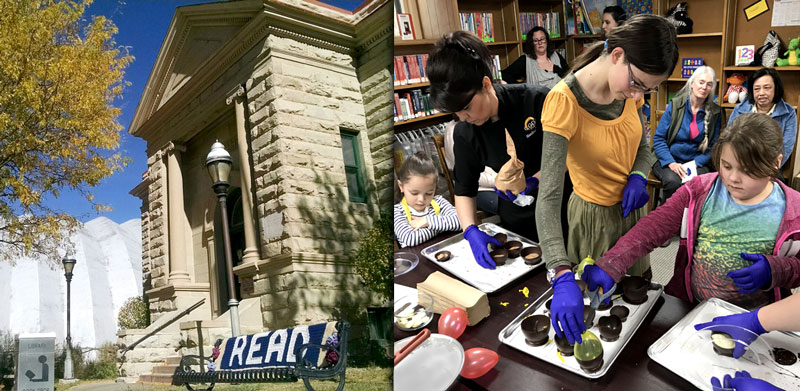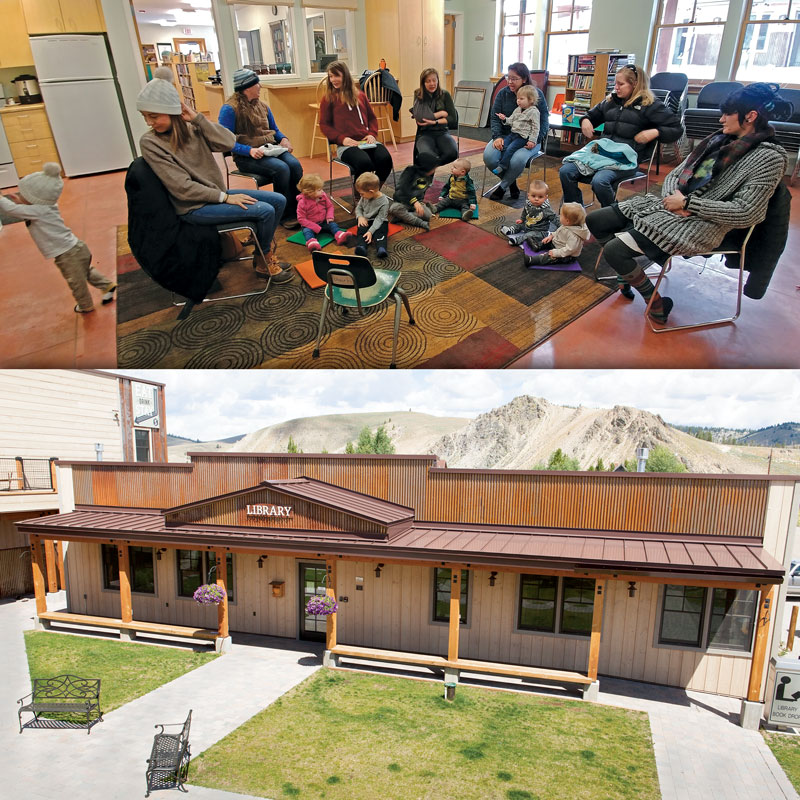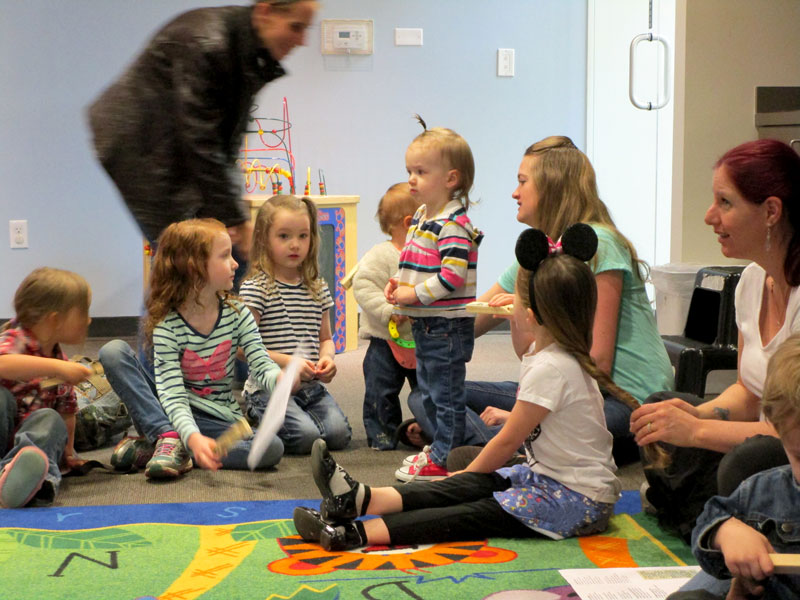Small Wonders: Rural and Small Libraries Provide Vital Infrastructure for Communities
In rural areas, a library's success can have less to do with circulation or program participation and more with meeting a range of needs for a community of 2,500 or fewer.
 |
A crowd celebrated solar “Eclipse Day” at the St. John Library in Washington state.Photo courtesy of Clancy Pool/ St. John Library |
There are many ways to measure a library’s success. In rural areas, it sometimes has less to do with circulation or program participation and more with meeting a range of needs for a community of 2,500 or fewer people.
In Trinidad, CO, one librarian spends most of her time securing food and services for her town’s homeless population. In Show Low, AZ, another librarian runs “adulting” classes to teach teenagers “the skills they don’t get in high school anymore.” And in Stanley, ID, the library’s Wi-Fi is such a draw that the librarian installed a router outside and added benches and power outlets so people can get online even when the library is closed.
In many of these communities, “the library is the living room of the town,” says Clancy Pool, the branch manager of the St. John (WA) Library. But more than a homey living room, libraries, as sociologist Eric Klinenberg wrote in a 2018 New York Times article, provide vital social infrastructures that “shape the way people interact,” like other shared spaces such as childcare centers, churches, synagogues, and parks.
That can be particularly true for rural libraries. When residents in Pool’s town told her there was a need for programming on the school’s early release days, she created STEAM programs for students. On the financial side, every business in her town of 550 residents contributes something to the library, she says, from money to goods she can use as prizes for patrons.
More than 6,000 of the country’s 17,000 individual libraries serve areas with populations of fewer than 2,500, putting them in the rural category, while small libraries serve populations of 25,000 or less, according to a 2017 American Library Association (ALA) report, “Rural Libraries in the United States.” Alaska and North Dakota have the most rural libraries, at 83.3 percent and 81.6 percent, respectively, according to a 2013 report by the Institute of Museum and Library Services. In eight additional states, including Vermont, Iowa, South Dakota, and New Hampshire, more than 70 percent of libraries are in rural areas.
These facilities feature just 1.9 average full-time staff in a building of roughly 2,600 square feet, slightly larger than the typical American house. One-third of full-time librarians in rural areas hold MLS degrees from institutions accredited by ALA, according to Lisa Lewis, president of the Association for Rural & Small Libraries (ARSL). About 60 percent of these libraries aren’t connected to a broader library system.
While their community value is often indisputable, funding can provide a particular challenge for these libraries. Almost 85 percent of U.S. library budgets come from local governments; 6.8 percent come from the state; and 0.5 percent from federal investments, according to the ALA report. With lower tax revenues in many rural areas, this can hurt, as does the fact that the average rural community is losing population and jobs. (Those outlier rural libraries in areas with seasonal, well-heeled tourists often draw more resources.)
While rural libraries vary widely, they share a lot of traits, often making do with a miniscule budget while trying to meet specific needs from a community that might range from a Native American reservation to a town of 48 people.
Chelsea Price serves those 48 people in her Meservey, IA, library. Though there are many small towns nearby, she says the nearest movie theater is about 30 miles away, and the closest school is 20 miles outside town. Even though her library is only open 20 hours a week and staffed by just her and one assistant, she knows her building is the town’s hub.
“I do think libraries are more important in towns like this,” she says. “There’s nothing else. There’s no community center, no bank, no gas station. There’s just a post office, a church, a bar, and the library.”
 |
A chocolate workshop at Colorado’s Carnegie Public Library of Trinidad, where director Mallory Pillard has also initiated programs to support the local homeless population.Photos courtesy of Carnegie Public Library of Trinidad |
Offering alternatives, not competition
Small budgets often result in libraries restricting what new materials they purchase as well as limiting extra help and programming. Hours for rural libraries typically range from 34 hours a week to just 26 hours for the most rural spots. The 2017 median salary for a rural librarian was $28,508.
In Pool’s library, she has one part-time employee who covers a Wednesday shift in her town of 550. The St. John Library is only open 16 hours a week, but Pool regularly goes offsite to read to youngsters in pre-K and kindergarten as well as seniors in the area’s assisted-living facility.
In her 17 years at the library, she recognizes that her job has changed from mostly “checking stuff in and out” to creating more programming. Because she shares a building with City Hall, she has a lot of flexible meeting space, she adds.
Still, she knows the importance of staying up-to-date in the community, so her programs don’t compete with other activities. “I adjust my programming for Vacation Bible school meetings, I know when swim lessons are going on.…There’s so few things to do, I don’t want to have three things on the same day.”
As in many rural communities, Internet access at the library is usually the strongest in town. Pool thinks nothing of letting residents into her library before it officially opens so they can complete Skype calls for their work.
 |
The Show Low (AZ) Public Library outreach vehicle is used for Head Start visits and other initiatives.Photos courtesy of Show Low Public Library |
Going beyond programming
When Mallory Pillard became the library director in Trinidad, a city of fewer than 9,000 in southwest Colorado, she wasn’t sure how to grapple with the large homeless population in her community. (While Pillard’s library is technically not rural, she shares many concerns with those libraries.) There wasn’t a strong network of services in the area, and finally, Pillard understood that a library’s responsibilities could be wider than what she expected. “I became passionate by necessity,” she says looking back on her five years in the town.
She created a food shelf where patrons can leave or pick up nonperishables or toiletries. That action has taken the least amount of time and provided the biggest payoff of anything the library has done, Pillard says. Now, her duties range from trying to help patrons who are homeless secure needed documents to simply finding boots and blankets when the weather turns cold and snowy.
The library also uses volunteers to create hygiene packs, small kits that include vital toiletries. And in a town where the local McDonald’s has turned off its Wi-Fi and taped over its electrical sockets to discourage people who are homeless from congregating at their location, Pillard understands that simply opening the library’s doors early on a cold morning can help some residents escape the weather.
She credits her “awesome team,” a staff of eight, with keeping more traditional library offerings humming when she’s working with people who are homeless or contacting area agencies for services. “I feel empowered to make more of an impact than in a bigger city,” Pillard says.
While rural libraries pride themselves on meeting the varied needs of their community, Iowa’s Price found out the hard way that trying to formalize this process wasn’t worth the effort. She created a patron survey to learn what residents thought about the library and ask about what services they wanted. Only two questionnaires were returned.
Price realizes the personal touch works best in Meservey. She visits the school four times a year, attends all city council meetings to report on the library’s activities, and simply listens to patrons who come in the library’s front door.
Every year, the library’s summer reading program ends with a free town carnival that usually attracts three times the town’s population. Price also features a monthly toddler storytime, frequent movie nights, and plenty of one-time programs including a Harry Potter party,
canvas painting, and a program run with the local humane society. With an annual budget of just $26,000, she relies heavily on grants and volunteers.
|
|
The Mommy and Me classes at Show Low (AZ) Public Library explore fitness, music, art, and tech. |
Lewis says social media still doesn’t beat word-of-mouth for alerting residents about programming. As the library services director in Show Low, she uses everything from the local paper to Facebook, Instagram, and Twitter.
In her first library job, she was the only full-time employee in an area of 1,500 people. Limited by a book budget of just $1,500 a year, she nevertheless increased traffic from 40 people a day to 250 by the time she left for Show Low. “It was challenging, but rewarding. We had an attitude of ‘We’re going to try. If something doesn’t work, we’ll just move on.’ ”
In her current position, Lewis says that creating programming for teens but pitching the idea to parents helped make her “adulting” series a success. Classes range from simple cooking and sewing lessons to how to live with a roommate and how to conduct yourself on a date. The series wrapped up with a dinner for teens and their parents.
Lewis also has a large number of homeschooled children in her area, so she asked these parents what type of programs they wanted. In response, her weekly activities cover STEAM topics and help supplement what parents are doing on their own. She offers a coding club, robotics club, and activities from making your own rockets to circuit boards; a small makerspace has quilting, vinyl applique, and other projects.
The summer-winter split
The same is true in Stanley, ID, where director Jane Somerville says her library is so small that she runs her children’s programs in the morning before she opens, because as the only librarian, most of the time, it’s impossible to check out books during storytime. Somerville runs a weekly Babies & Books program for newborns to three-year-olds and Learn and Play for children ages four and five. For children in school, she runs a Read’N’Feed program twice year. That’s where everyone reads the same book and then comes to the library to eat food featured in the books.
“During the winter, we’re the only thing going unless you go to a bar,” she says, adding that one of the town’s three bars does run a movie night and trivia contests. “We have more library cards [issued] than people in our district,” she adds, because the town’s population burgeons during summer vacation; Stanley is located within the two million acres of Sawtooth National Forest and about 60 miles north of Sun Valley. The area is home to some wealthy residents during the summer. With Wi-Fi in the mountains spotty, anyone trying to work during vacation typically comes into her 2,000-square-foot building, she says.
Somerville’s library is open 32 hours a week in winter, but she adds six additional hours during the busy summer months. However, with so many outdoor activities available then, she has learned not to run children’s programs during the summer.
 |
A weekly Babies and Books event (top) at the Stanley (ID) Community Library.From top: Photo by Aron Ames; photo courtesy of Stanley Community Library |
Darryl Quesada faces the same summer-winter split. As the regional librarian at the Whiteriver Public Library located within Arizona’s White Mountain Apache reservation, she discovered that paying attention to her area’s tradition was a necessity. When she tried to continue children’s programming into the summer, residents objected, saying, “life is awake” in the summer and storytime wasn’t needed.
“I’m not traditional, but I do want to respect other people,” Quesada says, adding that she now suspends children’s programming in the summer. Still, the winter brings its own challenges in an area where nine out of 10 residents are unemployed and living in poverty.
“Networking is a huge part of what I try to do,” she says. “The older generation is more reserved. They like to keep to themselves.” Transportation in the area remains a problem and with residents 20 miles away from the library in an area with an elevation of 2,000 feet, roads quickly become treacherous, she says.
Lewis says the annual ARSL conference is a great place to share ideas with like-minded peers. “It’s invaluable. It makes you feel like you’re not alone,” even if you are the library’s only full-time employee. Given funding challenges, the association is helpful in pointing out grants that are geared to small and rural libraries so staffers don’t feel like they have to always compete against larger systems.
Even with all the challenges a rural library can bring, a whopping 97 percent of rural librarians expressed satisfaction in their jobs, according to a 2007 survey. Lewis isn’t surprised. “There’s no place I’d rather be. We can make a whole lot of difference. You’re not just another library card member—we know who you are and we’re concerned about you. We make phone calls to check on regulars if we don’t see them for a while.”
Wayne D’Orio is freelance journalist and regular Hechinger Report contributor who frequently writes about education, equity, and rural issues.
RELATED
The job outlook in 2030: Librarians will be in demand
The job outlook in 2030: Librarians will be in demand
ALREADY A SUBSCRIBER? LOG IN
We are currently offering this content for free. Sign up now to activate your personal profile, where you can save articles for future viewing







Add Comment :-
Comment Policy:
Comment should not be empty !!!